Most antique sewing machines come built into a wooden table that holds a foot-powered treadle. Wooden sewing machine tables often have beautiful, intricate cast-iron legs and decorative carvings. Antique sewing machine table value varies depending on the brand and condition of the piece.
The average value for an antique sewing machine table containing a machine ranges from $100 to $500. For a table without a machine, the average value falls between $100 and $300. Tables in good condition or with a provenance like a Singer serial number will have a higher value.
In this article, you will learn about the components of an antique sewing machine and how it works. You will discover the value of popular antique sewing machine table brands. Finally, you will find tips on how to buy a sewing machine table for yourself!
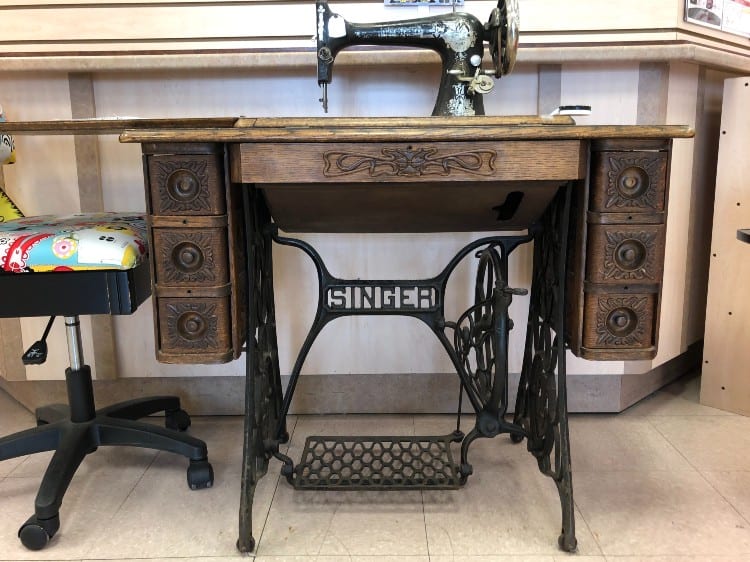
Quick Navigation
- What is a Sewing Machine Table or Cabinet?
- Antique Sewing Machine Table Value
- Are Older Sewing Machine Tables Worth Anything?
- Antique Sewing Machine Table Brands
- Vintage Tables
- How Do You Date a Singer Sewing Machine Table?
- Singer Sewing Machine Table Models
- What is the Oldest Sewing Machine Brand?
- Antique Sewing Machine Table for Sale
- How to Repurpose an Antique Sewing Machine Table
- Conclusion
What is a Sewing Machine Table or Cabinet?
A sewing machine table is a stand to hold an old sewing machine. In some cases, the table or cabinet also serves as the power source for the machine, as in the case of old foot-treadle models.
Many older sewing tables with cast iron legs also come with a hinge feature or flip top that allows the actual machine to fold down inside the table.
Back in the day, this meant that the table could serve multiple functions, which mattered when people had small houses and limited space available. You could do your sewing in the morning, then fold down the machine and use the smooth wooden surface of the table to write letters in the afternoon!
Keep in mind that antique sewing machine tables look quite different from modern ones.
If you search for sewing tables today, you will find a great variety of handy crafting tables that come with a well, or dip, to hold the sewing machine. This lets the machine sit level with the table for easier sewing. These tables have a lot to offer, but they look totally different from antique tables!
Most antique sewing machines come affixed to either a table or a wooden cabinet. Hand-crank sewing machines made in the early 1900s sometimes come with just a portable case. Antique tables usually come with the machine actually attached to the wooden structure.
This all-in-one design made it easier to connect the treadle, and later, the electrical wires, to the machine through the table. Older tables did not offer as much storage, though some models feature small drawers.
Also, as with most antique furniture, these tables and cabinets contain solid wood and metal and weigh quite a lot. In some cases, they have beautiful craftsmanship and special decorative details.
Antique Sewing Machine Table Value
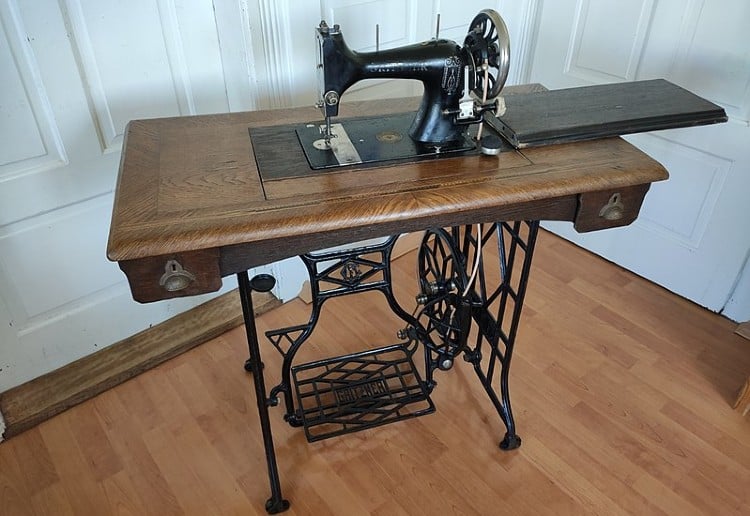
Source (1)
Antique sewing machine tables have an average value of $100 to $500, but you can find some models pricing well above or below that average range. The true value of a table depends on whether or not the sewing machine remains attached to it. Of course, the condition of the wooden table also plays a role in determining value.
The first sewing machine invented for public use was sold in 1830, but most of the antique machines you will come across today come from after 1850. This is because Isaac Singer sold the first Singer machine in 1850, and Singer sewing machines dominated the market for the next 100 years!
Technically, sewing machines made before 1900 are considered antique, and machines made between 1900 and 1950 are considered vintage. For the purposes of sewing machine tables, though, many of the popular models you will find, like Singer tables and cabinets, were made in the early 20th century.
Are Older Sewing Machine Tables Worth Anything?
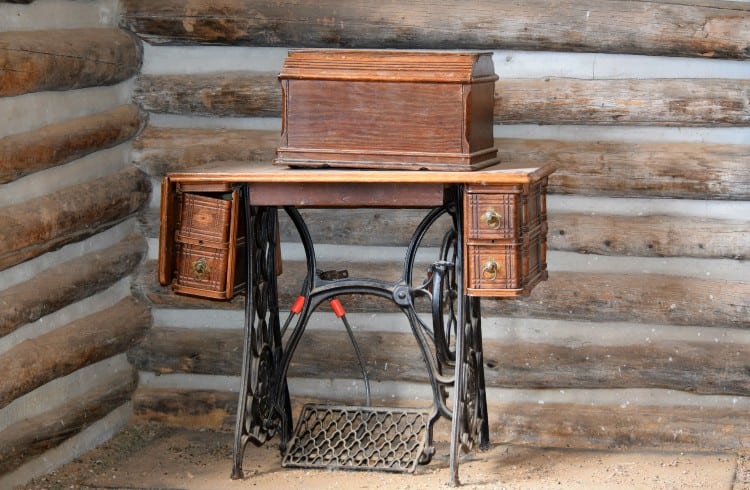
In rare cases, older sewing machine tables can sell for over $1000, though they usually sell for between $100 and $500. As with any antique, a lot of the value depends on the item’s collectibility. The world of antique sewing machines has certain brands and models that have become so rare that people collect them today.
Some of these include models like the Singer Red Eye, which can sell for $1,000 to $2,000! Very old models made in the mid-1800s often sell for more because of their rarity.
In most cases, the sewing machine table or cabinet must still contain the actual machine to hold much value. An old sewing machine table that no longer has the machine inside serves as more of a curiosity or decorative piece than a collectible. This gutted table can still make a nice end table or tiny desk, but you will not sell it for a lot of money.
On the other hand, you can find ideas on how to repurpose this lovely piece of old furniture later on in this article!
Antique Tables
Any sewing machine table made before 1900 falls into the antique category. This covers about 70 years of beautiful old-fashioned tables and cabinets made by popular brands like Singer and Wilcox & Gibbs.
So, what makes antique sewing machine tables so special? The concept of building a sewing machine into a wooden table came about partly because of the necessity for a foot-operated treadle. Pressing your foot up and down on this peddle-like metal grid spun a wheel inside the machine that powered the needle.
As a fun fact, Isaac Singer, founder of the famous Singer Sewing Machine Company, patented the treadle sewing machine. Singer sewing machine tables and cabinets remain the most prevalent and popular models today!
A cabinet maker named Thomas Saint invented one of the earlier precursors of the sewing machine way back in 1790, showing the close link between the cabinetry and the mechanics of the earliest sewing machines!
Some very successful sewing machine companies like Singer launched their own carpentry divisions to cut costs by making the machine and the table. Other companies focused on building factories to make the sewing machines and outsourced the carpentry for the tables.
In the early 1900s, manufacturers began to use electric motors to run sewing machines. Still, at this point, everyone had grown accustomed to seeing sewing machines on lovely wooden tables with cast iron legs, so the trend continued well into the 1950s!
Many antique tables have the brand name either marked in gilt somewhere on the table or worked into the iron near the foot treadle. Some antique sewing machine tables also bear a serial number that can help identify the make and model of the table.
Antique Tables with Drawers
Some antique sewing machine tables contain small drawers, often located at both ends of the table. This handy convenience simply allowed sewers to store extra needles, bobbins, and thread nearby as they worked. The popular Singer table with a built-in sewing machine that can fold down inside and cast-iron legs typically had a two-drawer setup.
But other Singer tables contained anywhere from one to seven drawers!
That said, drawers or no drawers do not necessarily impact the value of an antique sewing machine table. Usually, the price of a table depends more on its condition and its brand.
Antique Sewing Machine Table Brands
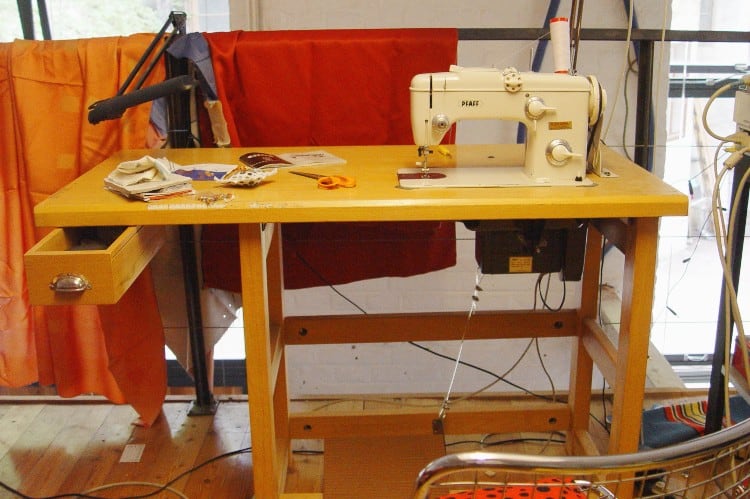
Source (2)
The big names you often see in antique and vintage sewing machine tables are Singer, White, and Pfaff. But in the heyday of sewing machine innovations, hundreds of companies sprang up to make and sell machines, tables, and cabinets!
While by no means a comprehensive list, this will give you a few key antique table brands to look for:
Bernina
The Bernina sewing machine company launched in Switzerland in the late 1800s, meaning that most of this company’s models fall into the vintage category. But the earliest Bernina sewing machines and tables are classified as antiques and can fetch quite a high price as collectibles.
Davis
The Davis sewing machine company began in the 1860s and delivered the precursor of the walking foot, which remains hugely popular with modern quilters! Even though these Victorian-era machines hold a place in history, they do not sell for too much today, with a typical price of around $100.
Grover & Baker
Grover & Baker operated for just a few years, from the 1850s to the 1870s, but they marketed the first-ever portable sewing machine during that time. Because of the extreme rarity of these models, they can sell for over $1,000 if you find a table still containing a working sewing machine!
Husqvarna Viking
Husqvarna Viking has a very long history as it began selling sewing machines in the mid-1800s and continues to sell them today! A few Viking models stand out as highly sought collectibles, such as the Freya model. It’s difficult to find an antique Viking machine on its table today, though many vintage models with good tables show up on eBay or antique malls.
Joseph Merrow
Joseph Merrow launched a sewing machine company in the 1830s, and his company went on to invent the overlock machine! Today, Merrow remains in business but focuses on industrial sewing machines. Vintage merrow models with tables made out of Formica pop up for sale quite often, but the old cast-iron Merrow models usually come without tables.
Pfaff
Pfaff holds the honor of remaining one of the most prestigious sewing machine brands in the world. Founded in 1862, this stellar German brand produced precise and powerful antique machines that often still run today! A few Pfaff models with tables remain highly collectible and may sell for around $1,000, but most antique and vintage Pfaff models will sell for an average price of about $200-$400.
Singer
Singer has remained one of the most famous sewing machine brands in the world since the 1800s all the way up to today! You can find out much about antique Singer tables later in this article.
Wilcox & Gibbs
Wilcox & Gibbs had a brief history compared to brands that still exist today, but these early sewing machines came ensconced in lovely wood-and-iron tables! Depending on the condition, they often sell for anywhere between $100-$400.
Vintage Tables
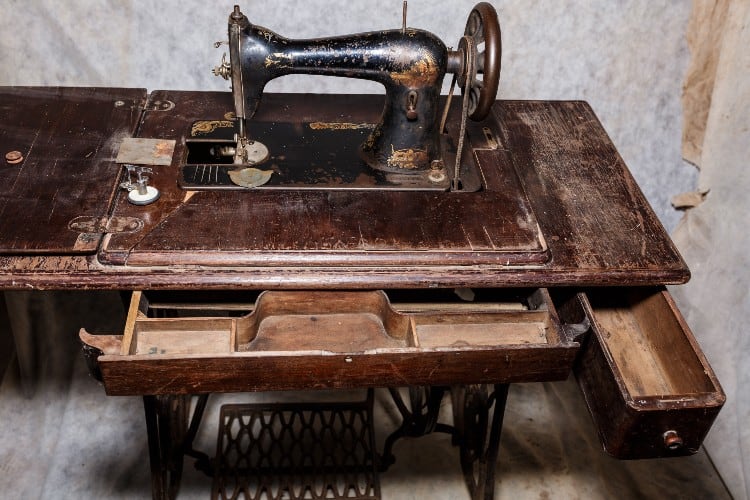
Sewing machine tables made after 1900 but before 1960 typically fall into the vintage category rather than the antique category. In some cases, machines made in the 1970s and even 80s may get classified as vintage.
Vintage sewing machine tables do not necessarily hold less value than antique models, though! In the early 1900s, as electric-powered sewing machines began to gain popularity, most sewing machine companies still needed solid furniture to hold the heavy metal machines they made.
Again, this list does not cover every company that sold tables or cabinets during this era, but you can get some of the key names to look for here:
- Brother sewing machines were first sold in 1908, and the company remains extremely influential today. You can find some early Brother models with the cast-iron legs so prominent in the early 20th century, but later models typically used a more retro-looking style of spare wooden legs and a long, hinged flip-top hanging off the side. Vintage Brother sewing machines have a good reputation for durability but do not often sell for more than a couple hundred dollars.
- The National Sewing Machine Company launched in 1890 and lasted until 1953. These machines typically have more value when sold with their wooden table or cabinet in good condition. But this brand never quite attained true collectibility, and even very good models will sell for just about $300.
- Necchi has the distinction of remaining one of the only prominent sewing machine brands to come out of Italy. Founded in 1924, the company sold technical and highly regarded sewing machines that still sell for $400 or $500 today. You can find Necchi models built into the classic cast-iron-leg model and mid-century versions that look like small wooden desks with the hinge flap off to one side.
- Janome is another Japanese company, this one launched in the post-WWII industrial boom in Japan. You can usually buy these vintage models for $100-$200, but they remain popular because many of them still work today! Not all Janome models came with a table, but you can find some midcentury models that came built into elaborate desks or 70s models with very spare wooden desks.
- White is another old American sewing machine company, founded in 1858 and quite prominent until the 1950s when global competition put them out of business. Of course, you can find many antique White sewing machines with built-in tables, but you can also find lovely vintage models with skillful carpentry and metalwork. The company actually owned a forest and built the beautiful tables and cabinets used for their machines, but sadly, they sell for less than $150 in most cases today.
Several prominent companies like Singer, Bernina, and Pfaff also continued making and selling sewing machines with tables during this era.
How Do You Date a Singer Sewing Machine Table?
You can often date a Singer sewing machine table by finding its logo and serial number.
First, the Singer logo might appear in several different spots on the table or cabinet. You want to find this logo to confirm that you have a Singer table and not another brand. Many brands copied Singer and made very similar models.
You could find the logo written out as the whole name “Singer,” sometimes worked into the cast iron above the treadle foot. You could also see the letter “S” marked out in gilt scrollwork on the wood somewhere or a sticker or painted S overtop of the picture of a seamstress.
Once you have confirmed the logo, look for a manufacturer’s label. This may look like a sticker, a metallic sticker, or a piece of printed paper. You often find this label on the back or underside of the table, in an inconspicuous place.
If you do not find the label, does your table still have a sewing machine attached to it? The machine should have a Singer sewing machine serial number on it.
Once you find an identifying item, such as the manufacturer’s label or the serial number, you can look up the model number and year of production on Singer’s website or the International Sewing Machine Association database!
Singer Sewing Machine Table Models
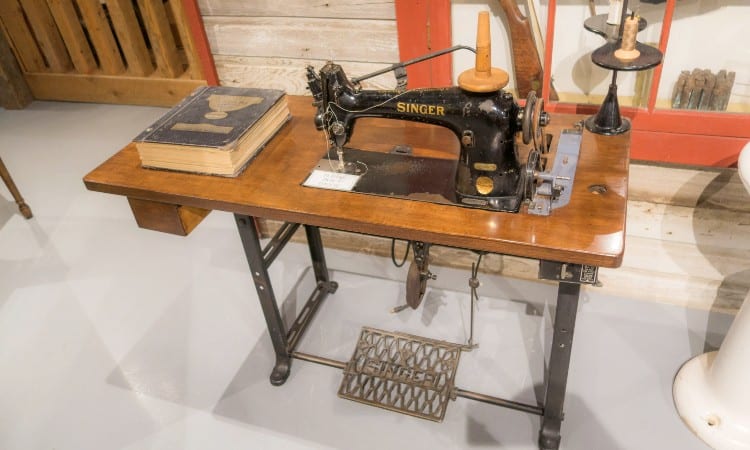
Source (3)
Singer made many different tables and cabinets for sewing machines over the years. These tables remain some of the most popular among collectors today, and you can often find them sold both with and without the actual sewing machine.
Despite the longstanding popularity of Singer sewing machines and tables, they do not usually command a high price. Except for a few rare, collectible exceptions that can cost as much as $2,000, most antique and vintage Singer sewing machines and tables will sell for between $50 and $500.
Tables by themselves usually sell for $100 or less, though the table’s condition could raise the price a bit.
The great thing about old Singer sewing machines is that you can easily find information about model numbers, production dates, and selling prices online. Singer offers a lot of information on the company website. Other reputable groups like the International Sewing Machine Collectors Society also provide free access to tons of information on these machines and tables.
Over time, Singer also developed a five-letter marking system to notate different kinds of tables and cabinets.
This system is quite confusing. The five-letter code “ALMYC” means a cabinet made in mahogany, for instance! But if you can locate the code on the manufacturer’s label inside your table, you may find it helpful as you look up info about your table.
To give you an idea of the huge variety of Singer sewing machine tables and cabinets out there, here are just a few models:
- The first popular Singer sewing machine, called simply Model A, came in a wooden box that turned into a table to mount the machine.
- The incredibly popular early 20th century models sold by Singer included the Class 15, the Class 9W, and the famous Featherweight Class. Each of these models could come in multiple different types of cabinet tables, featuring anywhere from 1 to 7 drawers, five different kinds of wood, and cast iron legs!
- Later models could come in a “library table” with elegant wooden legs and two side extensions. It usually had just one central drawer.
- The “drawing room cabinet” model is perhaps the most elaborate, intricate version of a sewing machine cabinet ever sold by Singer. This bulky wooden cabinet had front cabinet doors that opened out, lots of carvings, side extension tables on hinges, and a machine that could fold down inside for storage!
- The “enclosed cabinet” featured a way to lower the machine into the cabinet for storage and had two wide doors opening on the front of the cabinet.
- The simple extension table had four narrow wooden legs. The machine could fold down into the table, and the extension flap could unfold from the top out to the side to provide additional space while sewing. This model typically had one long, central drawer.
What is the Oldest Sewing Machine Brand?
Isaac Singer did not invent the first sewing machine, but the Singer brand was the first to successfully market sewing machines. Founded in 1851, this huge company amassed such popularity that it survived two world wars and even succeeded against stiff competition from Japanese models in the 1950s.
Some of the oldest Singer models can demand extremely high prices today because they have become so rare and collectible. Almost all antique Singer sewing machines came with tables or cabinets as well.
Antique Sewing Machine Table for Sale
You can find antique sewing machine tables and cabinets for sale online or at most antique stores.
Many online sellers on eBay and Amazon offer antique and vintage sewing machines for sale. You can also find refurbished models sold on Etsy or by local sewing machine companies through their own websites.
Plus, you almost never walk through an antique store without spotting at least one old sewing machine on a table!
So, finding old sewing machine tables for sale is super easy. The challenge is finding a good one!
If you want a table that will hold its value, look for these key characteristics:
- Smooth, polished wood with no knicks and scratches. If you see any gilt work or painting, these details should look bright and vivid.
- A sewing machine in good condition, preferably still able to run. Check for rust and see if you can find the serial number on the metal machine.
- A foot treadle that still works (if the table has one). Again, look for any rust on the iron.
- Hinges, doors, and extension flaps that work smoothly.
- A recognizable logo or brand name. Singer tables hold their value, but others like White or Brother do not have as much collectibility.
Finally, you also want to factor in your intended use of the table. If you want to sew on the sewing machine, you need to make sure the machine works! On the other hand, you may want the table itself for its decorative value. In that case, forget the machine and focus on the condition of the wood and metal in the cabinetry.
How to Repurpose an Antique Sewing Machine Table
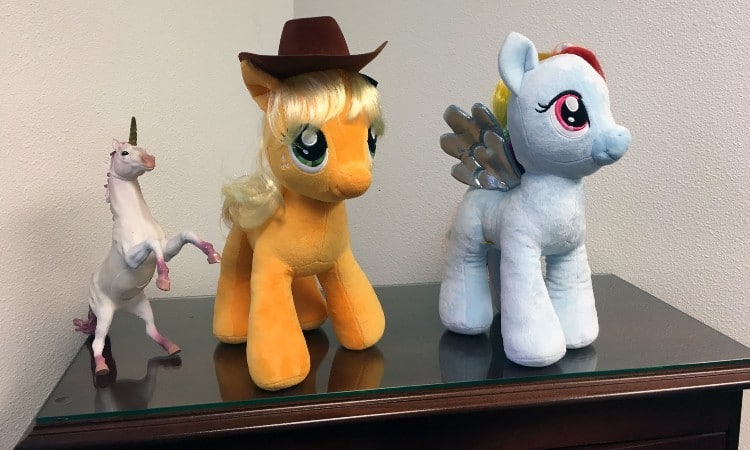
Source (3)
Old sewing machine tables have so much vintage charm that you can see them repurposed as TV stands, computer desks, plant holders, and more! If you have an antique sewing machine in the family and the machine itself no longer works, you may want to consider upcycling the beautiful table rather than getting rid of it.
For the absolute simplest option, find a table in good condition, keep it closed with the sewing machine inside, and use it as an end table or old-fashioned washstand with a pitcher on top. This will give a room instant Victorian bed-and-breakfast vibes!
If you like refinishing furniture, remove the metal legs from a foot treadle table and reattach them to a flat, polished wooden table top. You can use this as a side table, desk, TV stand, or even a small kitchen island!
If you don’t have great woodworking skills, try using those same metal legs and attaching them to a vintage suitcase. This creates a unique small table perfect for a hallway or bedside!
Finally, turn an old sewing table into the perfect vanity by placing velvet dividers for jewelry inside where the sewing machine used to rest.
Conclusion
Antique sewing machine table value today ranges from $100 to $500. The value of these tables depends on their brand, model, and overall condition. Tables that still have a sewing machine intact have a lot more value than tables without a sewing machine.
Many antique sewing machines were built into wooden tables or cabinets. Some sewing machine companies owned their own cabinetry departments, or even a whole forest, to provide this part of the sewing machine! Popular brands that made and sold these antique sewing machine tables include Singer, Pfaff, and White.
Do you have an old sewing machine table or cabinet? Can you figure out its brand and model? Leave a comment below to let us know!
(1) Shared under a Creative Commons (BY-SA) license
(2) PFAFF 261 photo by CsMFMAATSGOIS. Shared under a Creative Commons (BY-SA) license
(3) Shared under a Creative Commons (BY-SA) license